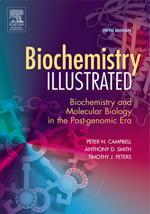This title gives students of medicine, other health professions and
science a coherent account of biochemistry and molecular biology.
Over 500 two-colour line illustrations help the reader visualise
biochemistry and understand difficult concepts. Gene structure and
function are introduced early in the book as they are so central to
the control and regulation of biochemical processes. This
organisation of content provides the reader with a logical sequence
of events that aids learning.
Features
*Highly visual presentation of subject
*Concentrates on essential core of knowledge
*Logical sequence of chapters with nucleic acids and protein
synthesis covered at start of book
-Contents -
The cellular basis of biochemistry. An introduction to proteins and
peptides. Nucleic acids and protein synthesis. Protein structure and
function with hemoglobin as an example. Proteins: specialised
functions. The structure and function of enzymes. Carbohydrate
structures and their interconversion. Nitrogen metabolism. Oxidative
catabolism of glucose and fatty acids. Carbohydrate and lipid
metabolism in the fasting state. Carbohydrate and lipid metabolism in
the absorptive state. Plasma lipoproteins, cholesterol metabolism and
atherosclerosis. The action of hormones and other effectors in
regulating glycogen and glucose metabolism, ketogenesis and
lipogenesis. Phospholipids, other substances and complex
carbohydrates. Biomembranes, receptors and signal transduction. The
post-genomic era and its impact on the future of biochemistry and
molecular biology.
Peter N. Campbell, Emeritus Professor of Biochemistry, University
College London; Anthony D. Smith, Emeritus Reader in Biochemistry,
University College London, London, UK; and Tim J. Peters, BSc, MSc,
PhD, Statistician, Department of Social Medicine, University of
Bristol, Bristol, UK


